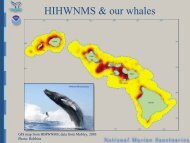The First International Conference on Marine Mammal Protected Areas
The First International Conference on Marine Mammal Protected Areas
The First International Conference on Marine Mammal Protected Areas
Create successful ePaper yourself
Turn your PDF publications into a flip-book with our unique Google optimized e-Paper software.
Panel 3: How Can MPAs and Networks of MPAs Ensure Threat<br />
Mitigati<strong>on</strong> to Cetaceans?<br />
C<strong>on</strong>vener and coordinator: Sim<strong>on</strong>e Panigada<br />
Rapporteur: Christine Gabriele<br />
Objectives:<br />
<str<strong>on</strong>g>The</str<strong>on</strong>g> general aim of this panel was to c<strong>on</strong>sider whether existing MPAs and MPA<br />
networks provide sufficient protecti<strong>on</strong> for marine mammals. A number of specific threat<br />
factors, al<strong>on</strong>g with the mitigati<strong>on</strong> measures that have been used to address them, were<br />
illustrated and evaluated. Panelists were also asked to c<strong>on</strong>sider how and whether broader<br />
nati<strong>on</strong>al acti<strong>on</strong> plans and regi<strong>on</strong>al c<strong>on</strong>servati<strong>on</strong> plans could be used to create more<br />
effective MMPA networks.<br />
Am<strong>on</strong>g the specific questi<strong>on</strong>s to be addressed were the following:<br />
• Do existing MPAs effectively protect marine mammals from ship strikes,<br />
bycatch, chemical polluti<strong>on</strong>, acoustic polluti<strong>on</strong>, prey depleti<strong>on</strong>, and habitat<br />
degradati<strong>on</strong>?<br />
• What elements need to be included in management plans to ensure that MPAs<br />
are achieving their goals?<br />
• What methods are available to characterize, assess, and manage synergistic<br />
effects?<br />
• Is critical habitat adequately identified and protected within existing MPAs?<br />
• What approaches are available to protect and manage critical habitat that is<br />
temporally and spatially dynamic?<br />
• How can multi-nati<strong>on</strong>al and high-seas MPAs be designed and managed?<br />
• What real-time tools are available to mitigate the risk of ship strikes in MPAs?<br />
Summary of Findings:<br />
A basic principle for ensuring that an MMPA or MMPA network is effective is<br />
articulati<strong>on</strong> of the management goals that address both ecological and socio-ec<strong>on</strong>omic<br />
dimensi<strong>on</strong>s. Objectives should be clear, achievable, and measurable. <str<strong>on</strong>g>The</str<strong>on</strong>g> success of any<br />
MMPA is founded <strong>on</strong> scientific understanding of the ecology and critical habitat of key<br />
species and awareness of human activities and potential threats. Science should, am<strong>on</strong>g<br />
other things, seek to understand the physical mechanisms that cause formati<strong>on</strong> and<br />
persistence of biological “hotspots,” focusing <strong>on</strong> patterns and processes such as<br />
retenti<strong>on</strong> z<strong>on</strong>es, bathymetric gradients, and upwelling. New design c<strong>on</strong>cepts, including<br />
dynamic boundaries that can be changed in “real time” and extensive buffers, should be<br />
c<strong>on</strong>sidered where appropriate. Periodic reassessment and re-evaluati<strong>on</strong> of objectives and<br />
effectiveness, both internally and by interdisciplinary panels of outside peers, is<br />
recommended. Establishing and maintaining public acceptance of an MMPA is<br />
accomplished through good stakeholder relati<strong>on</strong>s and a broad-based educati<strong>on</strong> program.<br />
All aspects should incorporate c<strong>on</strong>siderati<strong>on</strong> of local, traditi<strong>on</strong>al knowledge.<br />
ICMMPA <str<strong>on</strong>g>C<strong>on</strong>ference</str<strong>on</strong>g> Proceedings<br />
39



